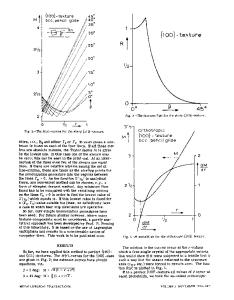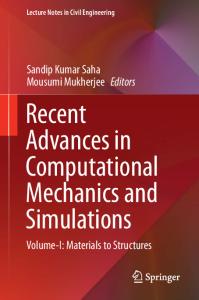Modeling of the plastic anisotropy of textured sheet
- PDF / 1,550,131 Bytes
- 16 Pages / 613 x 788.28 pts Page_size
- 55 Downloads / 336 Views
I.
INTRODUCTION
THE anisotropic properties of sheet metals have generally been described by two different methods, i.e., either a crystallographic approach such as that based on the Bishop and Hill yield surface or a macroscopic analysis employing various continuum yield functions. According to the former, the deformation of a polycrystalline aggregate is assumed to be accommodated by the activation of slip systems, the type of which depends on the metal under consideration. The crystallographic nature of plastic deformation is thus directly accounted for. The necessary transition from a single crystal to a polycrystal is then carried out on the basis of knowledge of the orientation distribution of the crystals (i.e., from the texture) as well as from the definition of a grain interaction model. By contrast, the analysis used in the continuum methods is completely different in spirit. In this case, no reference is made to the orientations of the individual grains, so that the approach remains essentially macroscopic. The yield locus of the polycrystal under consideration (from which the stress and strain rate characteristics are readily deduced) is described instead by an assumed analytical function, the parameters of which are determined experimentally. The anisotropic behavior of the aggregate is thus accounted for only through the characteristics of the yield surface and not by means of the crystallographic texture of the material which is recognized to be the primary source of plastic anisotropy. The validity and limitations of these two approaches are discussed in detail in Reference 1, with particular attention being paid to their use in the control of metal forming processes. The crystallographic methods are generally unsuitable for the rapid assessment of macroscopic properties, whereas the continuum techniques, because of their simple formulations, frequently fail to reproduce adequately some significant features of the plastic anisotropy. Recently, Montheillet et al. 2 have proposed an alternative method, known as the continuum mechanics of textured polycrystals or CMTP, which combines aspects of both the
PH. LEQUEU, formerly Graduate Student, McGilt University, Montreal, PQ, is with Research Center, Cegedur P~chiney, B.P. 27, 38340 Voreppe, France. J.J. JONAS is CSIRA-NSERC Professor of Steel Processing, Department of Metallurgical Engineering, McGill University, Montreal, PQ, Canada, H3A 2A7. Manuscript submitted October 30, 1986. METALLURGICALTRANSACTIONSA
previous approaches. This treatment is based on a modification of Hill's anisotropic continuum theory which permits the observed ideal orientations to be linked directly with the consequent plastic anisotropy of the material. The macroscopic stress and strain rate characteristics can thus be readily obtained from knowledge of the texture components displayed by the polycrystal. In this paper, the various grain interaction models used in such modeling are first discussed, followed by a description of the basic principles of the method. Some CMTP y
Data Loading...











